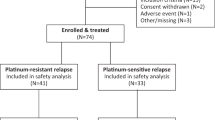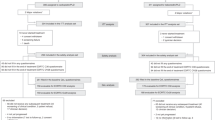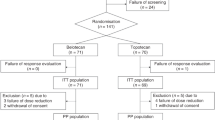Abstract
In phase I studies, lobaplatin showed activity in ovarian cancer patients pretreated with platinum. A phase II trial with lobaplatin was performed in patients with refractory or relapsed ovarian cancer to define activity and pharmacokinetics. Twenty-two patients were treated with lobaplatin administered as an intravenous bolus every 4 weeks. Dependent on creatinine clearance (CRCL) patients received 30 or 50 mg m-2 lobaplatin as the starting dose. Twenty-two patients received 78 courses (median 3, range 1-6). In eight patients total platinum (TPt) in plasma and urine, free platinum (FPt) in plasma ultrafiltrate (both measured by atomic absorption spectrometry) and lobaplatin in plasma ultrafiltrate measured (by high-performance liquid chromatography) were measured. Toxicity was confined to mild nausea and vomiting, mild leucocytopenia (WHO grade 3 in 18% of the courses), and renal function-related thrombocytopenia (WHO grade 3/4 in 53% of the courses). A correlation was found between CRCL and reduction in platelet count (r = -0.77; P < 0.01). No renal toxicity was encountered. Five of 21 evaluable patients (24%) achieved a response (four complete remissions and one partial remission). Remissions occurred mainly in patients who relapsed more than 6 months after primary treatment. The median survival from start of lobaplatin treatment was 8 months. The mean areas under the curve (AUCs) were 4.2 +/- 0.5, 3.0 +/- 0.6, and 3.2 +/- 1.1 h mgl-1 for TPt, FPt and lobaplatin respectively. The free platinum fraction (FPt/TPt) was initially very high, indicating low protein binding. FPt was essentially present as intact lobaplatin. Four hours after infusion 54 +/- 5% and 24 h after infusion 74 +/- 3% of the lobaplatin dose was excreted in the urine. In conclusion, lobaplatin is a platinum compound with anti-tumour activity in patients with relapsed ovarian cancer, especially in those who have platinum-sensitive tumours. The main toxicity of lobaplatin is thrombocytopenia and its dose should be corrected according to renal function.
This is a preview of subscription content, access via your institution
Access options
Subscribe to this journal
Receive 24 print issues and online access
$259.00 per year
only $10.79 per issue
Buy this article
- Purchase on Springer Link
- Instant access to full article PDF
Prices may be subject to local taxes which are calculated during checkout
Similar content being viewed by others
Author information
Authors and Affiliations
Rights and permissions
About this article
Cite this article
Gietema, J., Veldhuis, GJ., Guchelaar, HJ. et al. Phase II and pharmacokinetic study of lobaplatin in patients with relapsed ovarian cancer. Br J Cancer 71, 1302–1307 (1995). https://doi.org/10.1038/bjc.1995.252
Issue Date:
DOI: https://doi.org/10.1038/bjc.1995.252
This article is cited by
-
Pharmacokinetics and safety of lobaplatin plus etoposide in Chinese men older than 65 years with extensive-stage small cell lung cancer: a phase II clinical trial
Cancer Chemotherapy and Pharmacology (2019)
-
Randomized comparison of lobaplatin plus etoposide and cisplatin plus etoposide chemotherapy in patients with extensive-stage small cell lung cancer
The Chinese-German Journal of Clinical Oncology (2013)
-
Effects of lobaplatin and oxaliplatin on biological behavior of colorectal carcinoma cell line
The Chinese-German Journal of Clinical Oncology (2010)
-
Hyperthermia enhances the cytotoxicity and platinum-DNA adduct formation of lobaplatin and oxaliplatin in cultured SW 1573 cells
Journal of Cancer Research and Clinical Oncology (1997)



